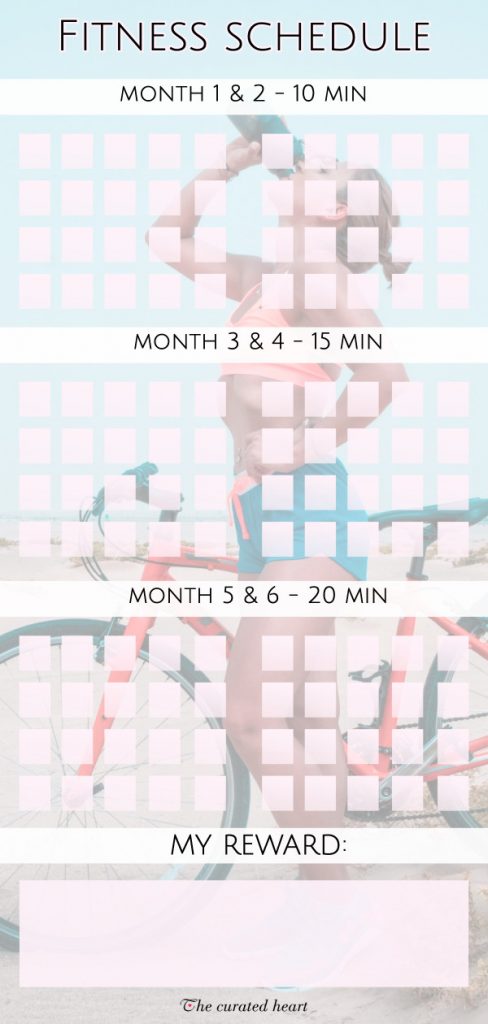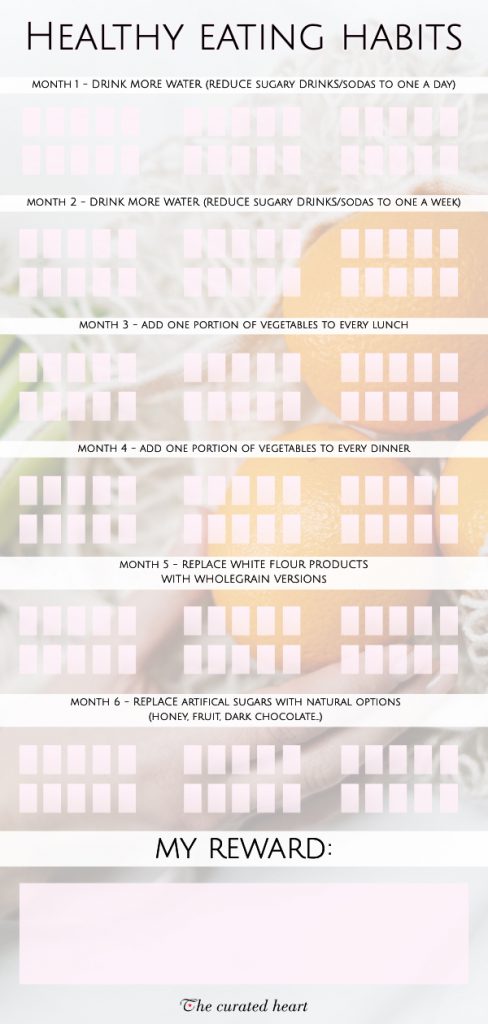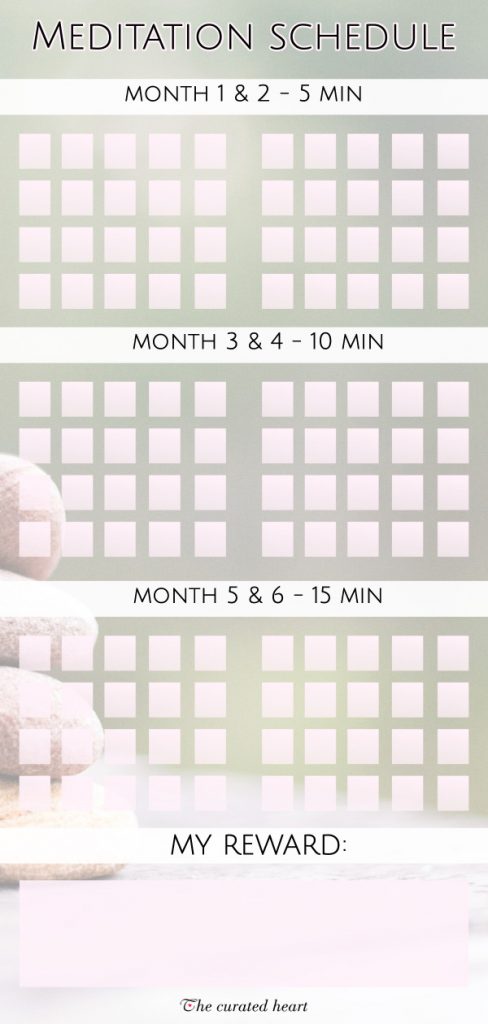It’s July which means the first half of the year is now officially over. And I know this year has been rather crazy, but I still want to take you back to your new year’s resolutions.
How well did you do? Did you achieve some of your goals? Did you change areas of your life that you wanted to change? And even if you didn’t decide on any particular goals, did your life improve?
These questions are not here to judge, but to help us stop and rethink if we like the direction in which we’re going. If you find some areas of your life that don’t seem to improve no matter how much you try, I want to help you by sharing what helped me when I was in the same situation.
I’ve previously talked about how to set goals in order to achieve them, but now I want to take it even a step further and share 5 practical tips that will give you the best chance of succeeding.

MY EXAMPLE
Before we start, let me quickly share why I needed to find a better system to stick to new habits.
When I was younger, I used to train for around 3-4 hours a day. But then, ten years after the busy training schedule ended, I couldn’t find a training routine that I could stick to for longer than three months.
More often than not, I was just fluctuating between good and bad weeks, without any consistency and enjoyment.
But in the last two years, I learned a lot about habit formation, so I decided to take my training schedule and go back to the drawing board to find out what was causing the problem.
And after a lot of trial and error, I found that by applying the next five rules, my chances of sticking to any new habit went from 20% to 70% or more.
Pretty cool, right? Now let’s jump right in…
SHIFT #1 – START SMALL (EVEN SMALLER THAN YOU THINK)
Whenever I was trying to create a new fitness schedule, I was always thinking about my end goals.
I was dreaming about my ideal fitness routine, and once I put it on a piece of paper, I thought all that is left for me to do is to stick to it. But that was my first mistake.
I believe we’re all heavily bombarded with this idea of overnight change. Sales techniques regularly include dramatic transformations (because that is what sells), so we slowly get this idea that changes should be quick and easy (or at least much easier than we think).
But as you probably experienced in the past, that is most often not the case – yes, it might happen, but it’s not that common. So we have to become aware of the trap of believing that if we don’t start big, we won’t see a difference, or that if we can’t stick to a new habit overnight, it’s our fault.
We have to learn to stop fighting with ourselves and calling ourselves weak/lazy/stupid and instead realise that we’re not designed to change all that much.
Our brain wants to be safe, that is pretty much all it cares about – survival and safety. So when we’re trying to implement something new, our brain resists it. And the more unfamiliar and uncertain the new thing is, the more resistance we get.
Knowing this can be very liberating. We can suddenly see that if we pace ourselves, we have much bigger chances of succeeding because our mind won’t be able to stop us every time we make a new adjustment.
When changes are small, the excuses are not there (or are very weak), and applying new things is often very effortless.
USE YOUR VISION AND BREAK IT DOWN INTO SMALLER GOALS
At my last attempt, I had the end goal of exercising for 25 minutes a day, five days a week, but for a change, I decided to build to it slowly.
I started with a 10-minute exercise routine that was my foundation. I knew showing up every day was crucial to making my habit stick, and because it was only 10 minutes, I had no choice but to do it.
Then I simply added 5 minutes every two months:
- 1st & 2nd month -> 10-minute routine
- 3rd & 4th month -> 15-minute routine
- 5th & 6th month -> 20-minute routine
- 7th & 8th month -> 25-minute routine (my END GOAL)
So if you ever feel like you just can’t stick to a new habit for more than 2-3 weeks, I suggest you break it down into smaller chunks and gradually build as you go.
Also, start even smaller than you think. I genuinely believe the first goal mark should look a bit laughable at first, but that is exactly how we want it. It has to be too easy not do it.
From my perspective, 10-minute workout seemed ridiculous, because I used to spend the same time warming up in the past. But I started with it anyways, and I’m glad that I did.

With all of this being said, this approach might not be necessary for every category in our lives. Some areas are going to be easier to change than others, and if you don’t have any problems sticking to your plans, then there is no need to change it.
This works best for areas where we’re struggling – so as a rule of thumb; the harder it’s for us to stick to a particular habit, smaller we should start and slower we should build.
SHIFT #2 – GIVE YOUR HABIT AT LEAST 2 MONTHS BEFORE MOVING TO ANOTHER ONE
By only focusing on our end goal, we can often forget that we need time before a habit becomes automatic. And that is precisely what we should be striving for. We shouldn’t aim to force ourselves to stick to something for x weeks; we should aim to automate our habits.
For some people moving their body every day is like breathing. And even if they have lazy moments and skip a few days, they quickly start missing it, because it’s a huge part of their identity and life.
It’s the same with brushing our teeth. We do it every day, and even if we’re really tired or lazy, we can’t imagine going to bed without doing it. So whatever your habit is, strive for automation.
HOW LONG DOES IT TAKE TO FORM A HABIT?
A lot of experts in the field of habit building suggest that it takes at least two months to form a habit. And the more complex and challenging the habit is, the longer it takes.
When I learned that, a lot in my life changed. In the past, I used to stick to something for 2 or 3 weeks thinking I can simply move on and the habit will work for me, but I was wrong.
I learned I need a lot more time for something to become automatic, even if it’s a small change, like drinking a glass of water as soon after waking up. So whatever your goal is, give it time!
SHIFT #3 – USE A HABIT TRACKER
You might’ve already heard about this one, but I never used them in the past. I believed that creating new habits is easy, so if I failed, I thought my willpower was the problem.
But now that I understand our brain doesn’t like changes, I use every tool I possibly can to keep myself going. And habit tracker is crucial when it comes to changing one’s life.
During the last few years, I tried many different trackers, so I can tell you what works best and why:
- I prefer a physical tracker as opposed to a digital one: with the first one, we get that satisfying feeling of crossing one more day off the list, it serves as a visual reminder, and once we see how many days we invested in something, it’s more likely that we’ll keep going.
- Put the tracker somewhere visible: to get all the benefits I talked about in the previous point, we have to put the tracker in a visible spot.
- Create a tracker for a longer period: to make your chances of success higher, always do at least one month for an easy habit, and at least two months, for a more difficult task.
I couldn’t imagine creating new routines without a tracker, so if you never used it before, try it.
SHIFT #4 – REWARD YOURSELF
Let’s be honest – we all have lazy days, and even if we plan to start small, we can sometimes be tempted to miss a day or two, or convince ourselves we’ll build this habit later when life is ‘less stressful’.
That is why we need any extra motivation that we can get. A simple solution? Reward yourself after completing the 2-month habit-building period.
This is here to give us that extra push, not to fuel our whole journey. We all know that internal motivation is what drives us in the long run, so replacing that with the external one, simply won’t work.
WHAT TO CHOOSE AS A REWARD?
Anything that will get us a sense of motivation but will also add value to our life. It can be an activity, such as a relaxing massage, getting a new exciting haircut, going to a concert or a lovely weekend away.
If you have something that you’re planning to purchase anyway, you can splurge a bit more on that item than you would otherwise. A great option is also adding something that will make your new habit even easier to stick to.
When I stopped drinking soda (diet coke was my version of a morning coffee), I knew I wanted to add a kettle to my kitchen because I was drinking more tea. So after 66 days of quitting cold turkey, I bought myself a cute pink Smeg kettle.

This was my extra motivation, and it was also a practical purchase that made my new habit of drinking tea even more enjoyable and fun.
So if you’re training more, you can add some small weights or new sneakers as your reward. If you’re meditating more, you can invest in a meditating app, and so on. This part should be enjoyable, but always make sure that whatever you pick adds value to your life, not take away from it.
Also, worth noting, that rewarding yourself with something that you’re trying to quit is not the best idea – for example: after quitting sugar don’t reward yourself with a big cake (been there, done that, haha).
SHIFT #5 – SIMPLIFY
Minimalism is a gift that keeps on giving, and luckily we can use it with our habit-building as well. Like I said, the more complex the habit, the longer it takes to form, and we can use this advice to our advantage.
When we’re looking to build a new fitness routine, going simpler is what will make our chances of success higher.
If we compare two possible versions; one is us, putting on sneakers, going outside and running for 15 minutes, and the other is a complicated schedule of cardio two times a week, core strength training once a week, the lower body once a week and lastly upper body once a week.
Even though the latter version is something we might want as an end goal, we should start more simply and then increase the complexity only once we feel confident in the habit we started with.
Also, decluttering and organising your tools around a specific habit can be an added bonus that will make sticking to your habit easier.
If fitness is one of your chosen habits to work on, check out the blog post about 6 amazing tips on how to declutter and organise your activewear collection once and for all.


BONUS – GOAL TEMPLATES
I really hope these five rules will help you as much as they helped me, and to help you jumpstart your new habits, I created some templates you can save and print to use as your habit trackers.
They’re here to help you get a little bit closer to your goals, so you feel accomplished by the end of the year. I included the most common goals, but if you have any special wishes, just apply the same principles and create your own little template.



I hope this helps! 🙂
If you enjoyed this post, I’d be very grateful if you’d help it spread by sharing it! Thank you 😉

A great post indeed, a lot of good ideas.
Author
I’m glad you like it!
Thanks so much for this post – I’m in the process of starting to implement some new habits in my life particularly in the field of daily exercise and I found this very helpful and encouraging.
I’m so glad you find this blog post helpful – and good luck with your new habits 😉